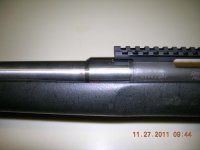4
4Mesh
Guest
Dennis, your bushing has an external thread that is 1.100-16. That translates to a minor diameter of 1.0233-1.0150. The internal thread in that bushing is a major diameter of .945-.9566. So, vs the original Remington as shipped situation, (minor Dia .9858-.9775) you have a considerable amount less material in a cylinder.I made the shoulder of the bushing the same diameter and .150" 'thick'. The length of the bushing from the front face of it is 1.100". That is .005" short of the front of the bolt lug and is very close to the go gauge measurement. The lug is pinned and fitted with a bit of coarse valve grinding compound between the action face and the lug and a jig is used to keep it lined up. The grinding compound compresses into the metal and keeps the lug from rotating and breaking the pin off when the threads are tightened.
The action was threaded to 1.100" x 16 tpi. The bushing was threaded to fit nicely by hand. The inside of the bushing is .945 x 20 tpi. I stamped the front of the recoil lug with 945 x 20.
The mating threads were cleaned well and Red Loctite was applied. Using a barrel stub to fit the bushings internal thread the bushing was torqued to 125 foot pounds.
Best case on the bushing, 1.0233-.945 = .0783 / 2 = .03915 per side of actual cylinder left. That ain't very much. Now, worst case would be 1.0150-.9566 = .0584 /2 = .0292 of wall thickness. 29 thou Dennis??? Now, I'm sure it isn't 29, but I'm pretty sure it ain't .039 either. So, either way, that ain't a hell of a lot of metal left in your twinsert.
Minor diameter on your tenon now becomes .8837-.8767. So, now the barrel has ~.350 over the belt, maybe .400 over the rest of the chamber regardless of the case. That's .200/side that's still cylindrical.
Call me a Doubting-Thomas, but I really doubt that .034 walled (nominal) cylinder actually withstood 125 Ft/Lbs. Lest you made that from some seriously tough stuff.
I don't doubt the whole thing 'can' work. But for someone who's crusaded safety as much as you have, I find this mod, being done by YOU, to be ironic.


